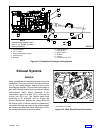
TP-5695 12/936-4 Installation
Location
General
Consider the following in selecting or constructing a
generator set location.
Compartment/location must allow adequate space for
ventilation, cooling and exhaust system installation,
service access to the engine and generator, and proper
fuel system installation.
Engine stringers or other available structural members
must provide adequate support for the generator set
weight.
A generator set compartment must be sealed to prevent
exhaust gases and fuel vapors from entering cabins.
Generator sets located above deck must have a
protective cover to prevent damage from rain and water
splash. This cover must not affect cooling air flow and
serviceability.
See Figure 6-4 for a typical installation and Section 1. for
dimensions and weights.
Space
Location should allow easy access to the generatorset’s
engine, controller, cooling, and fuel system components
for routine service. Engine compartments are often ideal
generator set locations, but access should not be
obstructed by propulsion engines or generator and
controller. Also allow clearance for vibration during
operation. Minimum recommended clearance for
vibration and cooling of top, front, rear, and sides of
generator set is 1 1/2 in. (38 mm).
Mounting
Engine stringers generally provide the best support for a
generator set. Any structural members considered for
mounting must support the generator set weight and
withstand engine vibration. The generator set includes
vibration mounts and mounting trays; additional
vibration isolating pads may be installed between trays
and bases.
A generator set should be mounted as high as possible
to avoid bilge splash and lower-lying vapors and also to
allow downward pitch of the exhaust line. For angular
installation, the maximum operation angle of the
engine/generator set is 20_ (in all directions).
Ventilation
Ventilation is required to support engine combustion,
generator cooling, and expulsion of flammable and
lethal fumes. Ventilation provisions must comply with
U.S.C.G. Regulations governing sizing of vents and
operator requirements.
As a rule, inlet and outlet vent areas should each be
sized to a minimum of 2 sq. in. per ft. (13 sq. cm/30.5 cm)
of craft’s beam. Should this rule in any instance conflict
with U.S.C.G. Regulations, appropriate Regulations
should be followed. If any screening is used in inlets,
size of hull/deck openings should be doubled. Vent
ducts should extend to bilges to expel heavier-than-air
fumes. If the generator set is to be mounted in the engine
compartment, air flow must be increased to allow for
generator set’s requirements. UL-listed ignition-
protected blowers should be installed in outlet vents,
and wired to operate before engine(s) are started.
Sniffer devices may also be optionally installed to cause
alarm, warning, or engine shutdown should dangerous
fumes accumulate in the compartment.
WARNING
Explosion.
Gasoline vapors can cause explosion and
severe injury or death.
Before starting generator set, operate blower 4
minutes and check engine compartment for
gasoline vapors.
Air requirements for various models are given in
Figure 6-5. The air intake silencer provides combustion
air to the engine. It is imperative that the recommended
minimum clearance of 1 1/2 in. (38 mm) between duct
opening and any enclosure wall not be compromised.
Engine/generator performance will be affected
adversely if these guidelines are not followed.
Air Requirements
CFM (L/min.)
Model Combustion Cooling
3.5CFZ 18 (510) 323 (9145)
4CZ 18 (510) 323 (9145)
5CFZ 18 (510) 600 (16988)
6.5CZ 18 (510) 600 (16988)
Figure 6-5. Air Requirements


















